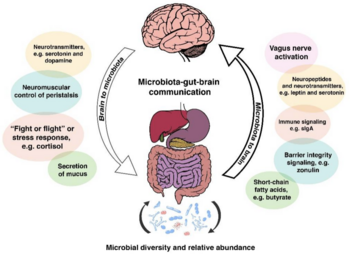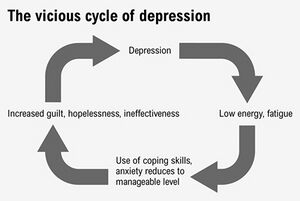The Human Gut Microbiome and Depression and Anxiety: Difference between revisions
No edit summary |
|||
| Line 33: | Line 33: | ||
[4] <b> The comorbidity of anxiety and depression | nami: National alliance on mental illness. (n.d.). Retrieved March 13, 2023, from https://www.nami.org/blogs/nami-blog/january-2018/the-comorbidity-of-anxiety-and-depression | [4] <b> The comorbidity of anxiety and depression | nami: National alliance on mental illness. (n.d.). Retrieved March 13, 2023, from https://www.nami.org/blogs/nami-blog/january-2018/the-comorbidity-of-anxiety-and-depression | ||
[5] <b> CDCTobaccoFree. (2022, September 14). Depression and anxiety. Centers for Disease Control and Prevention. https://www.cdc.gov/tobacco/campaign/tips/diseases/Depression is more than just feeling down or having a bad day. When a sad mood lasts for a long time and interferes with normal, everyday functioning, you may be depressed. | |||
[6] <b> Penny M Kris-Etherton, Kristina S Petersen, Joseph R Hibbeln, Daniel Hurley, Valerie Kolick, Sevetra Peoples, Nancy Rodriguez, Gail Woodward-Lopez, Nutrition and behavioral health disorders: depression and anxiety, Nutrition Reviews, Volume 79, Issue 3, March 2021, Pages 247–260, https://doi.org/10.1093/nutrit/nuaa025 | |||
<br><br>Authored for BIOL 238 Microbiology, taught by [https://biology.kenyon.edu/slonc/slonc.htm Joan Slonczewski], 2023, [http://www.kenyon.edu/index.xml Kenyon College] | <br><br>Authored for BIOL 238 Microbiology, taught by [https://biology.kenyon.edu/slonc/slonc.htm Joan Slonczewski], 2023, [http://www.kenyon.edu/index.xml Kenyon College] | ||
Revision as of 17:29, 13 March 2023
Introduction
By Hailey Moss

Humans exist in a microbial world. Microbes have inhabited the Earth for hundreds of millions of years, and humans have always coexisted with bacteria internally in the human body and externally in the environment.[1] Human physiology and the inhabiting gut bacteria once studied and thought to be separate mechanisms has recently been researched to a greater degree due to the discovery of the strong converse relationship between the microscopic residents' and human’s health and physiology. The trillions of microorganisms living mostly symbiotically within and on the human body are most commonly referred to as the microbiota, the ecosystem of bacteria, viruses, archaea and fungi within the host's central nervous system (CNS).[2] These symbionts are very important regulators of the microbiota-gut-brain axis, which is the interaction of the brain and gut through the body’s biochemical signaling pathways: the immune system, tryptophan metabolism, the vagus nerve and the enteric nervous system, including microbial metabolites such as short-chain fatty acids, branched chain amino acids, and peptidoglycans.[1] The gut-brain axis influences cognitive functioning and mood via these neural, hormonal, metabolic, and immune-mediated mechanisms.[2]
The gut microbiota has been found to have a powerful correlation with many psychological disorders, including depression and anxiety.[2] Depression and anxiety are debilitating and ubiquitous psychiatric conditions estimated to affect 10% of the world's population according to The World Health Organization.[2] The two comorbid conditions are seen to dually affect approximately 60% of those experiencing either anxiety or depression. [4] It is reportedly twice as likely for girls to develop clinical depression and anxiety starting around age 13 to 15 opposed to boys, although these psychiatric conditions become more co-current in males and females approaching adulthood. [3] Similar to many other psychological disorders, depression and anxiety are conditions that exhibit an extensive range of symptoms and severity, and the conditions manifest differently in each person affected by the disorders.
Depression and Anxiety
Depression is identified by long-term sadness and a constant negative mood affecting everyday function, activities, and normal behaviors. Depression is estimated to affect 1 of every 6 adults at some point in their life in The United States.[5] Some common symptoms are feeling sad or anxious often; feeling irritable‚ easily frustrated‚ or restless; abnormal sleep schedule and eating patterns; experiencing aches, pains, headaches, or stomach problems that do not improve with treatment; having trouble concentrating and making decisions; feeling guilty, worthless, or helpless; experiencing thoughts of self harm, and more.[5] The broad range of symptoms and severity of the condition can lead to a wide variety of functionality from person to person. Some cases of the disorder are moderate and lifestyle changes are minimal. Other cases can be debilitating. Severity of depressive disorders vary and the more critical cases include major depressive disorder, dysthymia, and bipolar disorder, each of which causes significant impairments of functionality in everyday life.[6]

Section 3
Include some current research, with at least one figure showing data.
Section 4
Conclusion
References
[1] Cryan, J. F., O’Riordan, K. J., Cowan, C. S. M., Sandhu, K. V., Bastiaanssen, T. F. S., Boehme, M., Codagnone, M. G., Cussotto, S., Fulling, C., Golubeva, A. V., Guzzetta, K. E., Jaggar, M., Long-Smith, C. M., Lyte, J. M., Martin, J. A., Molinero-Perez, A., Moloney, G., Morelli, E., Morillas, E., … Dinan, T. G. (2019). The microbiota-gut-brain axis. Physiological Reviews, 99(4), 1877–2013. https://doi.org/10.1152/physrev.00018.2018
[2] Simpson, C. A., Diaz-Arteche, C., Eliby, D., Schwartz, O. S., Simmons, J. G., & Cowan, C. S. M. (2021). The gut microbiota in anxiety and depression – A systematic review. Clinical Psychology Review, 83, 101943. https://doi.org/10.1016/j.cpr.2020.101943
[3] Chaplin, T. M., Gillham, J. E., & Seligman, M. E. P. (2009). Gender, anxiety, and depressive symptoms. The Journal of Early Adolescence, 29(2), 307–327. https://doi.org/10.1177/0272431608320125
[4] The comorbidity of anxiety and depression | nami: National alliance on mental illness. (n.d.). Retrieved March 13, 2023, from https://www.nami.org/blogs/nami-blog/january-2018/the-comorbidity-of-anxiety-and-depression
[5] CDCTobaccoFree. (2022, September 14). Depression and anxiety. Centers for Disease Control and Prevention. https://www.cdc.gov/tobacco/campaign/tips/diseases/Depression is more than just feeling down or having a bad day. When a sad mood lasts for a long time and interferes with normal, everyday functioning, you may be depressed.
[6] Penny M Kris-Etherton, Kristina S Petersen, Joseph R Hibbeln, Daniel Hurley, Valerie Kolick, Sevetra Peoples, Nancy Rodriguez, Gail Woodward-Lopez, Nutrition and behavioral health disorders: depression and anxiety, Nutrition Reviews, Volume 79, Issue 3, March 2021, Pages 247–260, https://doi.org/10.1093/nutrit/nuaa025
Authored for BIOL 238 Microbiology, taught by Joan Slonczewski, 2023, Kenyon College
